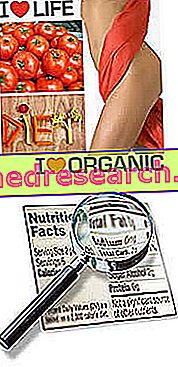What's this
What is wild red rice?
Wild red rice is the name of some species of rice (genus Oryza ) that are commonly called wild, not because it is impossible to reproduce them in captivity, but to distinguish them from the most common cultivated species known as O. sativa .

The various types of wild red rice, of which from now on we will speak as if it were a single group, are typically integral and of a light garnet color, a tone given to it by the concentration of anthocyanins or anthocyanins - unlike the common rice which, in its form integral, it is brown.
Since the nutritional factors that characterize it are entirely concentrated in the outer aleuronic layer, the wild red rice is sold only wholly or partially processed - semi-raw rice.
Did you know that
Brown rice is not made from the whole grain - paddy rice or raw rice - but from the endosperm with the embryo and the aleuronic layer attached. The external woody pericarp, represented by the bracts or glumelle, intended for animal feed or other uses (fuel, etc.), is absent. In jargon, the waste from the first processing is called chaff or chaff or slag.
Compared to white rice, exposed to a sort of smoothing - to remove the aleuronic layer and the germ - and to shine, the wild red has a higher nutritional value.
Red rice has a typically nutty flavor and a characteristic odor, but both are less intense than basmati rice. The recipes that involve the use of this ingredient are mainly ethnic, in particular Asian; it is not suitable for risottos.
Types of wild red rice
The most popular types of wild red rice are:
- Longistaminated Oryza and Oryza punctata : the two best known species like "red rice"
- Oryza sativa indica (subsp): famous as spicy rice, it is a subspecies of low yielding rice that persists in traditional rice cultivations
- Rakthashali : a rare variety of reddish-colored rice
- Thai Cargo : a variety of long-grain glutinous rice
- Bhutanese : a medium-grain rice grown in the kingdom of Bhutan, in the eastern Himalayas
- Camargue : a recent variety of rice grown in the wetlands of the Camargue region, in the south of France
- Kerala Matta : also known as Rosematta, Palakkadan Matta, Kerala Red and red parboiled, is a variety of indigenous rice but grown in the Palakkad district, in Kerala. It is also popular in Sri Lanka, where it is used for idle and appam.
Nutritional Properties
Nutritional properties of wild red rice
What are anthocyanins?
Chemically, anthocyanins fall into the flavonoid class and are synthesized via the phenylpropanoid pathway. Each anthocyanin molecule is made up of the union between an anthocyanidin and a glucide.
Anthocyanins are water-soluble plant pigments contained in cellular vacuoles of leaves, stems, roots, flowers and fruits. Depending on the pH, they may appear red, purple or blue. Their primary biological function is defense against abiotic stress (oxidation, UV rays, cold, etc.) and from the aggressions of some pathogens. Anthocyanins are therefore widespread in many foods, including: vegetables, vegetables, sweet fruits, aromatic herbs, seeds, roots, spices etc. Some examples are: purple cauliflower, açaí, red oranges, cranberry, currant, black grapes, maqui, aubergine, cherries, black rice, raspberries, black soy, purple or black corn etc.
Anthocyanins are odorless and tasteless; cause a slightly astringent reaction. In the food industry they are commonly used, in natural form, to color food and drink; however, due to the lack of data on their food safety, in 2013 the European Union denied its use as additives or food supplements. Exceptions are those of red-black grapes and blackcurrants, whose use history has amply demonstrated their safety levels. In other countries of the world they are instead granted without discrimination.
Wild red rice anthocyanins: do they work?
Wild red rice is rich in anthocyanins or anthocyanins. While carrying out clear protective functions in the plants in which they are contained, as nutritional factors for humans they have only presumed - or poorly confirmed - an antioxidant task. This "should", but only in theory, also correlate with various effects such as: anticancer, beneficial for metabolic balance, antimicrobial, etc.
The doubts on the human metabolic impact of the anthocyanins - of the foods that contain them - arise from the fact that, despite having demonstrated certain effects in vitro, they have not yet been confirmed in vivo. It is possible that this discrepancy depends mainly on their "reactivity". It appears that less than 5% of the anthocyanins taken with food and drinks are absorbed as such, while the remaining 95% undergoes transformations and interactions, losing its original function or being expelled rapidly.
Let it be clear, it is undeniable that after eating foods rich in anthocyanins, such as wild red rice, increases the antioxidant function in blood plasma. However it is not said that this depends specifically on the anthocyanins, but could instead derive more generally from an increase in the levels of residual uric acid from the metabolism of flavonoids. At the same time, it cannot be excluded that some anthocyanin catabolites may be reabsorbed in the gastrointestinal tract at a later time, to enter the circulatory stream, distribute themselves in the body and exercise the aforementioned metabolic effects. For the sake of clarity, we specify that in 2017 the research concluded that there is no substantial clinical evidence to indicate that dietary anthocyanins can reduce the risk of human diseases.
Other nutritional properties of wild red rice
Wild red rice has all the nutritional characteristics of brown rice. It belongs to the III fundamental group of foods, as a nutritional source of carbohydrates, fiber, specific vitamins and minerals. It is sold dry, which is why it has a low concentration of water and a high caloric-nutritional density, especially of complex carbohydrates. This is why rice and cereals in general are often considered high-calorie foods; in reality, once cooked they halve or even activate to contain only 1/3 of the initial energy.
Calories, as anticipated, are mainly supplied by carbohydrates, followed by proteins and finally by very few lipids. Carbohydrates have a mainly complex structure and are made up of starch. Peptides, on the other hand, have a medium biological value - with lysine-limiting amino acid. Fatty acids tend to be unsaturated-polyunsaturated, with the presumable importance of omega 3 essential fatty acids - alpha linolenic acid - and omega 6 - linoleic acid.
The fibers are very abundant. It does not contain cholesterol, lactose, gluten and histamine; brings modest amounts of purines.
It has a good concentration of water-soluble B vitamins, especially niacin (vit PP), riboflavin (vit B2), B1 (thiamine), B6 (pyridoxine) and folate. If it keeps the portion of the germ, also of fat-soluble tocopherol (vit E). The quantity of minerals is appreciable, in particular as regards phosphorus, zinc and iron - although the latter is not very bioavailable.
Overall, it can be described as richer than white rice.
Diet
Wild red rice in the diet
Wild red rice is suitable for most diets. It is suitable, in the right portions - and in any case, more than the refined one - even for the low-calorie slimming diet; the fibers of which it is rich also have an important satiating effect. With the same trick, it has no contraindications even for metabolic pathologies, provided that one keeps in mind not to exaggerate in case of type 2 diabetes mellitus and hypertriglyceridemia.
The richness in polyunsaturated fats makes it advisable against dyslipidemias such as hypertriglyceridemia and hypercholesterolemia, but also against high blood pressure.
Peptides, of medium biological value, can be easily compensated by association with the seeds of legumes. In this way, even following a vegetarian and vegan diet, it is possible to obtain the entire pool of essential amino acids.
The abundance in fibers makes wild red rice ideal to prevent and combat constipation - better if associated with abundant water; a diet high in fiber is also considered preventive against colon cancer. These also favor the modulation of nutritional absorption, reducing the glycemic index of the meal - useful action in case of type 2 diabetes mellitus and / or hypertriglyceridemia - and moderating the absorption of cholesterol in addition to the reabsorption of bile salts. The fibers also play an important prebiotic role, nourishing the bacterial flora of the colon.
The richness in water-soluble vitamins of group B makes wild red rice a very useful food to supply all the coenzymatic molecules necessary for the various cellular processes. Vitamin E and zinc are powerful antioxidants.
Phosphorus is rarely lacking in the diet but it is however one of the most abundant minerals and of which the body needs higher quantities - in the skeletal hydroxyapatite and in membrane phospholipids, especially in nerve cells. Iron is not very bioavailable but still present; to optimize absorption, it is advisable to combine wild red rice with nutritional sources of vitamin C.
This rice lends itself to the diet of celiac, lactose intolerant and histamine. It has no contraindications for hyperuricemia and gout.



